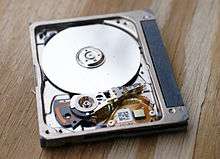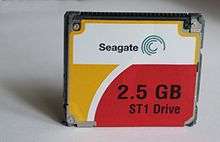Microdrive


Microdrive is a registered trademark for miniature, 1-inch hard disks produced by IBM and Hitachi. These rotational media storage devices were designed to fit in CompactFlash (CF) Type II slots. The release of similar drives by other makers led to them often being referred to as "microdrives" too. As of 2015, Microdrives are viewed as obsolete, having been eclipsed by solid-state flash media in read/write performance, storage capacity, durability, physical size, and price.
History
Prior to the 1-inch Microdrive, a 1.3-inch HDD was developed and launched in 1992 by HP with a capacity of 20 MB. These units weighed about 28 g (1 oz), with dimensions of 2.0" x 1.44" x 0.414" (50.8 mm x 36.5 mm x 10.5 mm) and were the physically smallest hard drives in the world before the Microdrive.
In 1999, IBM launched the first generation 1-inch Microdrive with storage capacities of 170 MB and 340 MB.[1] The physical dimensions of Microdrive were 1.65" x 1.42" x 0.197" (42.0 mm x 36.0 mm x 5.0 mm) and conformed to CompactFlash Type II card standard. A second generation of Microdrive was announced by IBM in 2000 with increased capacities at 512 MB and 1 GB. Following the merger of IBM and Hitachi HDD business units, Hitachi Global Storage Technologies continued the development and marketing of the Microdrive. In 2003, 2 GB and 4 GB models were announced[2] by Hitachi, followed by 6 GB capacity model in 2005.

In 2004, Seagate launched 2.5 and 5 GB models, and referred to them as either 1-inch hard drives or CompactFlash hard drives due to the trademark issue. These drives were also commonly known as the Seagate ST1. In 2005 Seagate launched an 8 GB model. Seagate also sold a standalone consumer product based on these drives with a product known as the Pocket Hard Drive. These devices came in the shape of a hockey puck with an integrated USB 2.0 cable.
In 2003-07-16, a Chinese manufacturer called GS Magicstor, Inc. (subsidiary of GS Magic, Inc.) announced it had produced 1-inch hard disk drive with capacity of 2.4GB at the beginning of the year 2003,[3] originally marketed as an alternative to Microdrive by Hitachi Global Storage Technologies.[4] It was to be followed by 2.2 and 4.8GB 1-inch HDD that was unveiled in 2004 International CES, with 0.8-inch HDD.[5][6][7] In 2004-12-28, Hitachi Global Storage Technologies announced it had filed lawsuit against GS Magicstor, Inc., GS Magic, Inc., and Riospring, Inc. for infringement of multiple Hitachi GST's patents relating to hard disk drives,[8][9] after GS Magic Inc. had started promoting mini-HDD (small form factor hard disk drive).[10]
As of July 2012, there are no known manufacturers of Microdrives.
Microdrive models by timeline
Date of release of large sizes.
| 1999: | 170 megabyte, 340 megabyte (IBM) |
| 2000: | 512 megabyte, 1 gigabyte (IBM) |
| 2003: | 2 gigabytes, 4 gigabytes (Hitachi) |
| 2004: | 2.5 and 5 gigabytes (Seagate) |
| 2005: | 6 gigabytes (Hitachi), 8 gigabytes (Seagate) |
| 2006: | 8 gigabytes (Hitachi) |
Advantages
- Until 2006, Microdrives had higher capacity than CompactFlash cards.
- Microdrives allow more write cycles, making them suitable for use as swapspace in embedded applications.
- Microdrives might be better at handling power loss in the middle of writing. Flash storage always needs to move some old data around while writing, to ensure the flash's finite write life is consumed equally; if there were a bug in the wear levelling algorithm it could cause data loss if the card were unplugged at the exact wrong time. Data on a disk is modified in place, and hard drive algorithms have many years more experience and testing over Flash.
Disadvantages
- As of 2006, Microdrive's capacity advantages were exceeded by CompactFlash cards[11] (which are the same size and are often compatible with each other), and USB flash drives.[12] As of 5 July 2015, 512 GB CF cards are available, offering 42 times the storage space of the largest Microdrive.
- Being mechanical devices they are more sensitive to physical shock and temperature changes than flash memory, though in practice they are very robust and manufacturers have added several features to the more recent models to improve reliability. For example, a microdrive will generally not survive a 4-foot (1.2-meter) drop onto a hard surface whereas CF cards can survive much higher falls.
- Microdrives are not as fast as the high-end CompactFlash cards; they generally operate at around 4–6 megabytes per second while high-end CF cards can operate at 45 megabytes per second. This may cause problems for photographers who shoot sequences of large images in rapid succession. Also, they require some time to spin up when they have been idle (see below).
- They are not designed to operate at high altitudes (over 10,000 feet or 3,000 meters), but can be safely used on most commercial aircraft as cabins are generally pressurized.
- Only high capacity models are manufactured, as it is not profitable to make low-capacity Microdrives. At the end of 2005 only capacities above 2 GB are manufactured while 256 MB and 512 MB CompactFlash cards were still in production. Lower capacities are still readily available second hand on eBay but these are usually the same price as CF cards of the same size.
- Unlike flash storage, Microdrives require power even when no data is being transferred to or read from them, just to keep the disk spinning in order to maintain quick access. As a result, many devices such as the iPod mini leave the drive switched off for most of the time while periodically starting it up to fetch data from it to fill the device's buffer. Microdrives will switch off after idling for more than a few seconds to counter this problem; however this means that it needs to spin up for the next access, which takes about 1s. This effect would be particularly problematic if an operating system is being run from the drive.
- Since they are thicker than flash-based CF cards, Microdrives require a Type II slot. Many newer compact cameras only have a Type I slot due to the increasing popularity of flash-based cards, so Microdrives have limited popularity outside of the professional photography market.
- Certain bus-powered CF card readers lack the power needed to run a Microdrive although they do take CF II cards. When using such a device, it will usually be detected by the host but errors will occur once the user attempts to access the drive.
- Some "OEM Only" drives use the CompactFlash form factor but only provide a 5 V IDE/ATA interface. These will not work in readers or devices which expect a 3.3 V interface and full CompactFlash functionality[13].
Microdrive models by manufacturer
IBM Microdrive
- 170 MB
- 340 MB
- 512 MB
- 1 GB
- 4 GB
- 8 GB
Hitachi Microdrive
- 512 MB
- 1 GB
- 2 GB
- 3 GB
- 4 GB
- 6 GB
- 8 GB
IBM and Hitachi models were fitted with 128 KB of cache memory.
GS Magicstor
Seagate ST1
- 2.5 GB
- 4 GB
- 5 GB
- 6 GB
- 8 GB
- 12 GB
These Seagate models were fitted with 2 MB of cache memory.
Sony Compact Vault
- 2 GB (rebadged Hitachi)
- 4 GB (rebadged Hitachi)
- 5 GB
- 8 GB
Toshiba
- 2 GB
- 4 GB
Cornice
- 4 GB
- 8 GB
Western Digital
- 2 GB
- 4 GB
- 6 GB
See also
References
- ↑ IBM ships the world's smallest hard drive
- ↑ World's Smallest Hard Drive Now Bigger: 4GB on a One-Inch Disk
- ↑ The Meeting of Productions Announcement
- ↑ David Chu Reshapes 1" HDD Industry
- ↑ GS Magicstor Announces 1-Inch Hard Drive
- ↑ Conference highlights high-tech industry
- ↑ GS Magicstor Inc. unveils groundbreaking 1" HDD at 2004 International CES
- ↑ Howard French (5 March 2005). "The New York Times > Business > World Business > Whose Patent Is It, Anyway?". China: Nytimes.com. Retrieved 2012-11-03.
- ↑ Hitachi Files Patent Infringement Complaint against GS Magicstor Companies
- ↑ Guizhou Important Technologies News Conference - Focus on mini-HDD
- ↑ SanDisk introduces the world’s highest capacity card for professional photographers - the 16-gigabyte SanDisk Extreme III CompactFlash
- ↑ Corsair launches 16GB Flash Voyager drive
- ↑ "Seagate ST1 5Gb not working on Canon 20D". 2005.
It IS a hardware issue. The CF2 interface has been disabled, and therefore the drive will ONLY work in IDE mode (that's why it won't read in a CF reader on the PC as well).
External links
- Review: IBM's 1GB Microdrive – review on MP3 Newswire
- Hitachi Global Storage Technologies (HGST)
- Review of Seagate ST1 5 GB 1-inch hard disk for CF
.svg.png)